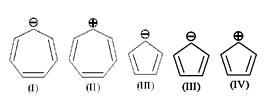Which of the following species will be aromatic ?



None of these
To determine which of the given species is aromatic, we need to apply the criteria for aromaticity. The main criteria are:
1. Cyclic Structure: The molecule must be in a ring form.
2. Planarity: All atoms in the ring must be in the same plane.
3. Conjugation: There must be a continuous overlap of p-orbitals, allowing for delocalization of π electrons.
4. Hückel's Rule: The molecule must have 4n+2 π electrons, where n is a non-negative integer (0, 1, 2, ...).
Now, let's analyze the given compounds step by step.
Step 1: Analyze the first compound
- Cyclic: Yes, it is a cyclic structure.
- Planar: Yes, all carbon atoms are in the same plane.
- Conjugation: Yes, there is conjugation due to the presence of π bonds and a positive charge that can participate in resonance.
- Count π Electrons: There are 4 π electrons (2 from each of the two π bonds).
- Hückel's Rule: Since 4 is not in the form of 4n+2 (it would be anti-aromatic), this compound is anti-aromatic.
Step 2: Analyze the second compound
- Cyclic: Yes, it is cyclic.
- Planar: Yes, all atoms are in the same plane.
- Conjugation: Yes, there is conjugation due to the positive charge and π bonds.
- Count π Electrons: There are 2 π electrons from the π bond and 2 from the positive charge (considering resonance).
- Hückel's Rule: 2 π electrons fit the 4n+2 rule (with n=0), making this compound aromatic.
Step 3: Analyze the third compound
- Cyclic: Yes, it is cyclic.
- Planar: Yes, it is planar.
- Conjugation: No, there is no conjugation because one of the carbons is sp³ hybridized and does not participate in π bonding.
- Count π Electrons: Since there is no effective conjugation, we cannot count π electrons in the same way.
- Conclusion: This compound is non-aromatic.
Final Conclusion
Only the second compound is aromatic.
Summary of Results
- First compound: Anti-aromatic
- Second compound: Aromatic
- Third compound: Non-aromatic
Answer:
Only option (b) is aromatic.
---
2. Planarity: All atoms in the ring must be in the same plane.
3. Conjugation: There must be a continuous overlap of p-orbitals, allowing for delocalization of π electrons.
4. Hückel's Rule: The molecule must have 4n+2 π electrons, where n is a non-negative integer (0, 1, 2, ...).
- Cyclic: Yes, it is a cyclic structure.
- Planar: Yes, all carbon atoms are in the same plane.
- Conjugation: Yes, there is conjugation due to the presence of π bonds and a positive charge that can participate in resonance.
- Count π Electrons: There are 4 π electrons (2 from each of the two π bonds).
- Hückel's Rule: Since 4 is not in the form of 4n+2 (it would be anti-aromatic), this compound is anti-aromatic.
- Cyclic: Yes, it is cyclic.
- Planar: Yes, all atoms are in the same plane.
- Conjugation: Yes, there is conjugation due to the positive charge and π bonds.
- Count π Electrons: There are 2 π electrons from the π bond and 2 from the positive charge (considering resonance).
- Hückel's Rule: 2 π electrons fit the 4n+2 rule (with n=0), making this compound aromatic.
- Cyclic: Yes, it is cyclic.
- Planar: Yes, it is planar.
- Conjugation: No, there is no conjugation because one of the carbons is sp³ hybridized and does not participate in π bonding.
- Count π Electrons: Since there is no effective conjugation, we cannot count π electrons in the same way.
- Conclusion: This compound is non-aromatic.
Only the second compound is aromatic.
- First compound: Anti-aromatic
- Second compound: Aromatic
- Third compound: Non-aromatic
Only option (b) is aromatic.
Similar Questions
Knowledge Check
Which of the following species is not aromatic ?
A B
B C
C D
D
Which of the following species is not aromatic ?
A B
B C
C D
D
Which of the following species is aromatic ?
A B
B C
C D
D


